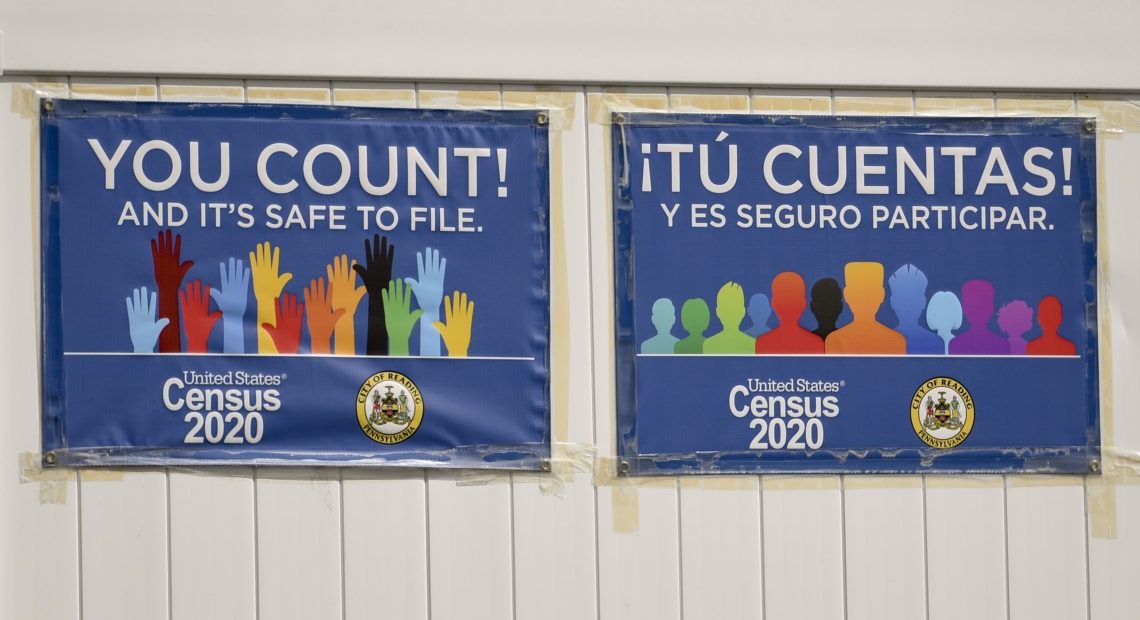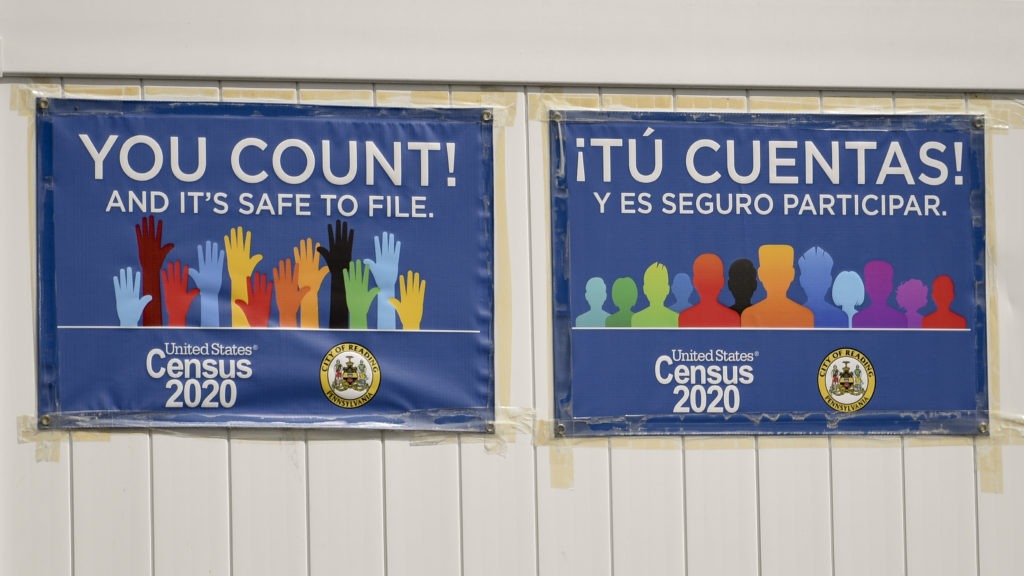
Millions Of Census Records May Be Flawed, Jeopardizing Trump’s Bid To Alter Count
BY HANSI LO WANG
The Census Bureau has found irregularities in records for this year’s national tally that, if left unfixed, could miscount millions of people.
This latest development enlarges the scale of an ongoing setback to President Trump’s push to exclude unauthorized immigrants from a key census count — an unprecedented change that Trump may not be able to make, regardless of how the Supreme Court rules in a legal challenge over whether the president can alter numbers that federal law and the Constitution say must include the “whole number of persons in each state.”
Leaked documents obtained by the House Oversight and Reform Committee previously confirmed that as of late last month, the bureau identified what it has described as “processing anomalies” that affect more than 1 million records for the 2020 census.

Signs promoting the 2020 census hang on a fence in Reading, Pa., in September. The Census Bureau has found irregularities in this year’s census responses that could affect the counting of millions of people.
CREDIT: Ben Hasty/MediaNews Group/Reading Eagle via Getty Images
But the number of potentially flawed records has ballooned into the millions, according to a person familiar with census operations who was not authorized to speak for the bureau. The agency has unearthed major inconsistencies in the information it has gathered this year about residents of college dorms, prisons and other group living quarters — a category that, for the 2010 census, included around 8 million people.
The time it will likely take to resolve these anomalies — as well as any additional ones that may pop up in the coming weeks — adds to mounting complications that could cement the bureau’s inability to put together the first set of census results before the end of Trump’s term in January.
Bureau officials have instructed teams within the agency to try to determine the exact magnitude of the problem and come up with potential solutions by Sunday, as first reported by The New York Times.
The Census Bureau and Commerce Department, which oversees the bureau, have not responded to NPR’s requests for comment.
During oral arguments before the Supreme Court on Monday, the Trump administration’s attorney, acting Solicitor General Jeffrey Wall, called the timing of the release of census results — as well as the state-by-state count of unauthorized immigrants that Trump would need to carry out his plan — a “fairly fluid” situation.
Leaked documents detailed ‘anomalies’
The internal documents released by the House Oversight Committee this week show that, as NPR and other news outlets have reported, the bureau is on track to miss the legal deadline of Dec. 31 for reporting the latest state population counts used to determine each state’s share of votes in the House of Representatives and Electoral College for the next decade.
Federal laws require those numbers to be handed off from the commerce secretary to the president and then to Congress. The new congressional apportionment counts are ultimately certified by the Clerk of the House, which remains under Democratic control and may not accept any altered numbers from Trump.
Nonetheless, the process for reapportioning congressional seats may end up taking place during the administration of President-elect Joe Biden, based on the timeline outlined by the leaked files.
One of the documents, dated Nov. 27, also warns of a “significant overcount” in some college towns because of an irregularity affecting more than 240,000 dorm records.
Running out of time?
In previous years, the bureau has run into similar snags after wrapping up tallying counts.
What is unusual with this year’s count is that under the sped-up schedule the Trump administration is trying to impose on the bureau, the agency’s staffers are running out of time to correct errors and run additional quality checks.
Some career officials inside the Census Bureau are concerned that Trump may eventually force the release of census data that don’t meet the bureau’s quality standards.
The administration has already made decision after decision that have rebuffed career civil servants’ warnings about serious risks to accuracy.
In addition to ending counting early, the administration has forced the bureau to make cuts to its plans for reviewing census results for flaws. Because of delays caused by the coronavirus pandemic, that process was expected to continue through April 2021. But in July, after deciding to stop asking Congress to extend legal reporting deadlines to allow for the extra time, Trump officials pumped up pressure on the bureau to put out results in time for Trump to receive them while in office.
That abrupt shift upended the bureau’s plans around the same time Trump issued a presidential memo in July. It calls for the bureau to come up with a count of unauthorized immigrants that could be subtracted from the census apportionment numbers for the first time in U.S. history. Three lower courts have blocked that memo after finding it unlawful, and the Supreme Court may weigh in with its ruling as soon as this month.
Truncating a quality check
To try to meet the administration’s demands, the bureau quietly canceled an external quality-checking effort scheduled for September that would have allowed state demographers to help resolve errors in the bureau’s records about college dorms and other group quarters.
Because a federal judge temporarily suspended the administration’s plans to end counting early, that count review operation was ultimately rescheduled and 39 states provided updates to the bureau’s files. The bureau confirmed to NPR in October that around 500 additional group quarter facilities were flagged for census workers, also known as enumerators, to count.
Still, during a House Oversight Committee hearing on Thursday, Joseph Salvo, New York City’s chief demographer, raised concerns about the accuracy of this year’s data about group quarters given all of the last-minute changes.
“There are some jurisdictions in this country with large numbers of … group quarters that define who they are, and it’s a distribution that affects some areas much more than others,” Salvo told lawmakers. “We are very concerned that the truncation of the schedule, less time in the field to get those answers, has caused the Census Bureau to push their enumerators to a point where, frankly, we’ve compromised the data itself.”
Any errors in the national head count could skew how much of an estimated $1.5 trillion a year in federal funding each community gets for Medicare, Medicaid and other public services, distribution that is based partly on census data.
They could also affect the distribution of political power over the next 10 years.
In response to the leaked documents about the million or so potentially flawed records publicly known at the time, the bureau released a statement on Wednesday emphasizing that the irregularities “affect less than seven-tenths of one percent of records.”
But relatively small differences between state population counts can have a big impact on how representation in Congress is divided up.
After the 2010 census, North Carolina lost the last House seat to Minnesota because of a difference of fewer than 15,800 people. And after the count in 2000, Utah lost to North Carolina because its tally of residents came in shorter by 856.















